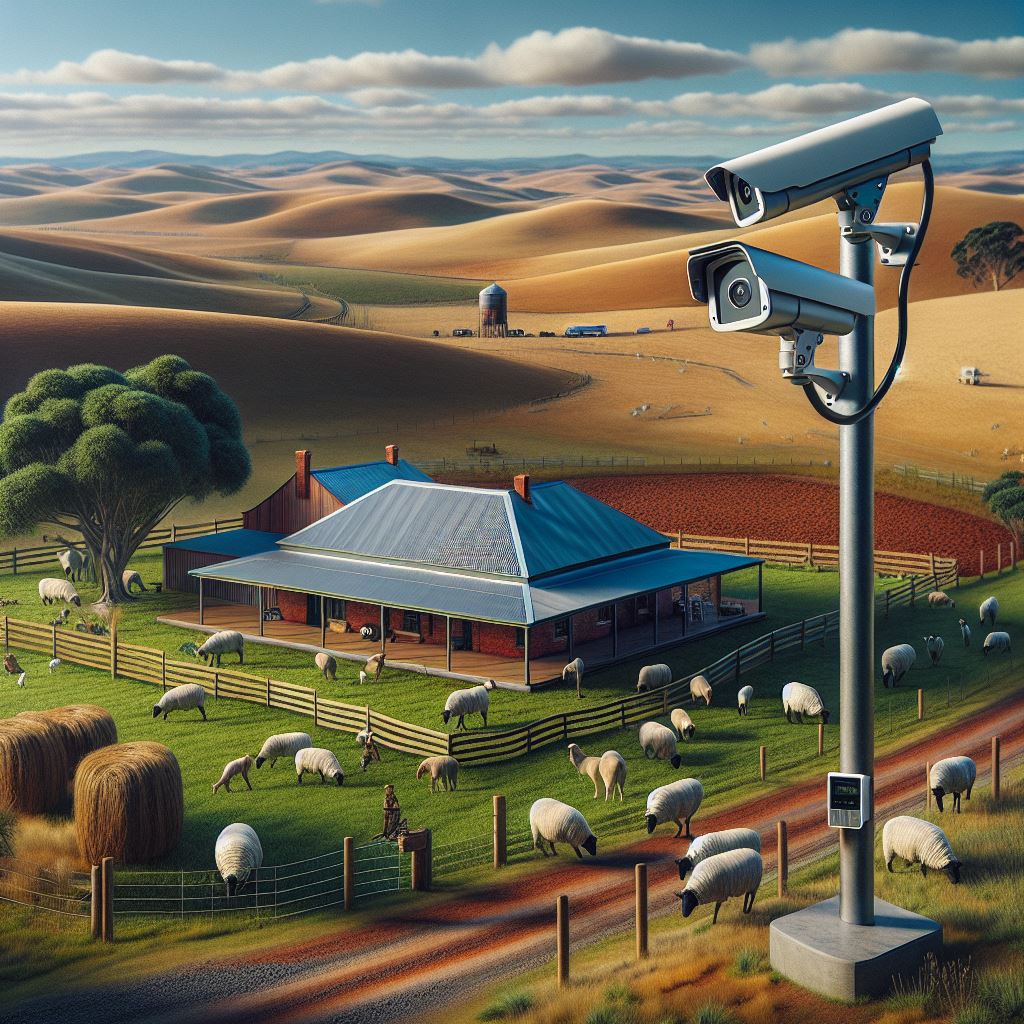A Comprehensive Guide to IP Surveillance Systems and Cameras for Rural Holdings and Farmers, ensuring Security and Monitoring for Farm Wellbeing
It has been typical over the past few decades that advancements in IT and Telecommunications has not reached Australia’s rural areas. Although this true to some extent, the advent of advanced technology in monitoring and surveillance systems has made it possible for rural holdings and farmers to implement sophisticated IP surveillance systems and cameras. Gone are the old cumbersome farm CCTV systems of the past with a maze of coaxial cables and blind spots. These systems not only enhance security but also provide valuable insights into the wellbeing and maintenance of their farms, crops, pasture, and livestock. This article will explore the types of IP surveillance systems available, explain their working principles, suggest optimal placements, discuss power options including solar energy, and highlight the benefits of remote monitoring.
Types of IP Surveillance Systems and Cameras
Farm Security Camera Systems for rural holdings and farms come in various types, each with unique features catering to different needs. Most farm security systems include a combination of the different types deepening on the location, required scope and power availability. The most common types include:
Fixed IP Cameras
Fixed IP cameras are stationary cameras that provide a constant view of a specific area. These types of cameras are typically the hardiest and can withstand heavy rain and other harsh weather conditions. They are an excellent choice for monitoring entrances, livestock areas, sheds, homesteads and critical points around the farm. These cameras offer high resolution video stored either locally and/or remotely. Most come standard with night vision capabilities.
PTZ (Pan-Tilt-Zoom) IP Cameras
A PTZ camera can pan, tilt, and zoom, providing a wide coverage area and the ability to focus on specific details. These cameras are perfect for larger spaces such as open fields or pastures, where a single outdoor camera can replace multiple regular cameras.
Wireless Cameras
Wireless cameras are easy to install and can be placed in locations where wired cameras are impractical. These typically use a WIFI network to transmit video data, making them suitable for remote areas of the farm where wiring is difficult to implement.
Internet Of Things (IOT) Cameras
Many remote cameras and monitoring devices in Australia are now taking advantage of either the Internet Of Things IOT, 4g or 5G networks. These cellular network devices have an inbuilt mobile sim card that provides them direct internet access. These can be the best choice for proving live feeds and professional monitoring of devices.
Bullet IP Cameras
Bullet cameras are designed for outdoor use and are typically mounted on walls or poles. They have a long cylindrical shape and are weatherproof, making them suitable for monitoring the farm’s perimeter and open fields.
Dome IP Cameras
Dome cameras have a dome-shaped housing that makes them less obtrusive and more resistant to tampering. They are ideal for indoor use, such as monitoring inside sheds, barns, storage areas, and other farm buildings.
How IP Surveillance Systems Work
IP surveillance systems work by capturing video using IP cameras and transmitting the video data over a network to a central recording and monitoring system. Here is a step-by-step explanation of the process:
- Video Capture: IP cameras capture high-resolution video footage and convert it into digital signals.
- Transmission: The digital video signals are transmitted over a wired or wireless network to a Network Video Recorder (NVR) or cloud-based storage.
- Storage: Many cameras allow the local storage of video surveillance locally on SD card. In conjunction with this , the centralised NVR will also record all video signals from all cameras. Sydney Data Cabling also recommends sending video data to an off site location such as our own purpose built cloud, a public cloud or another location owned by yourself. Utilising cloud storage allows for easy access and retrieval but be sure to check where this data is stored and if that location aligns with your privacy governance as well as confirm you have a sufficient Internet Connection for all devices.
- Monitoring: Live footage can be monitored in real-time or reviewed later using a dedicated computer or workstation, smartphone, or tablet. Remote monitoring allows farmers remote access to their property either simply from their desk at the homestead or anywhere in the world.
Optimal Placement of IP Cameras
Proper placement of IP cameras is crucial for maximizing their effectiveness. Here are some strategic locations for placing cameras on a farm:
- Entrances and Exit Points: Fixed high resolution cameras should be installed at every point of Ingres and Egress. These cameras can be set to motion detection of certain areas. It is essential to use a high definition, high-quality video, with night vision camera at these junctures to ensure clear images of license plates to pass onto law enforcement if required.
- Livestock Areas: Place cameras in barns, stables, and pastures to monitor the health and behaviour of animals.
- Fields, Pastures and Crops: Install cameras in fields to monitor crop growth, detect pests, and identify any signs of distress.
- Perimeter: Secure the perimeter of the farm with cameras to detect any unauthorized access or potential threats.
- Storage Areas: Monitor storage sheds, barns, and equipment areas to prevent theft and ensure the safety of valuable assets.
- Houses or Homesteads: With Houses and homesteads often left vacant during extended periods of time for cropping and mustering, it is essential an array of motion detection cameras keep a watchful eye on the premises.
Powering IP Cameras
IP cameras require a reliable power source to function efficiently. It is also necessary to consider a power redundancy or backup system as this is typically the weakest point of any security and/or surveillance system. There are several ways to power IP cameras on a farm:
Wired Power
Wired power involves connecting the cameras to a power source using electrical cables. This method is reliable but may not be practical for remote or hard-to-reach areas. Remember i Australia you will require a licensed electrician to perform any mains, 240 volt or three phase wiring.
Battery Power
Battery-powered cameras offer greater flexibility in placement, as they do not require a direct connection to a power source. These cameras are typically used for temporary or add-hoc surveillance. Trail Cam is a great example of these devices, whereby a stand alone camera is mounted to a tree and triggered by movement for short periods of time. Battery life of Trail Cams vary depending on the amount of video recorded or if they are only taking stills. Typical times range from 1-2 months to just under a year.
Solar Power
Solar power is an excellent option for powering IP cameras in remote areas. Solar panels convert sunlight into electrical energy, which can be used to power the cameras. This method is eco-friendly and cost-effective in the long run.
Utilizing Solar Power for Remote Cameras
Solar power is an ideal solution for powering IP cameras in remote locations where traditional power sources are unavailable. Here’s how solar-powered cameras work:
- The Solar Panel: The Solar Panel, or Panels are installed near the camera. These capture sunlight and convert it into electrical energy.
- Solar Charge Controller: A solar charge controller regulates the energy flow from the solar panels to the batteries, preventing overcharging and ensuring optimal performance.
- Batteries: Batteries store the electrical energy generated by the solar panels, providing a continuous power supply to the cameras, even during cloudy days or night time.
- Camera Operation: The stored energy powers the IP cameras, enabling them to capture and transmit video footage.
Benefits of a Complete Camera System with Remote Monitoring
Implementing a complete IP surveillance system with remote monitoring offers much more than a security system for rural holdings and farmers, allowing them numerous benefits :
Enhanced Security
A comprehensive camera system helps deter theft, vandalism, and unauthorized access. Real-time monitoring allows for quick response to security breaches.
Improved Farm Management
Remote monitoring provides valuable insights into the daily operations of the farm. Farmers can install additional cameras to track and monitor farm events. Typical applications are listed below, allowing farmers to monitor systems and detect issues early, allowing for timely intervention.
- Track the movement of animals
- Monitor gauges, weather devices and valves
- Inspect water troughs and resiviors
- Check gates, fences and laneways
- Monitor pasture, crops and grazing.
Bio Security
Having cameras mounted on all entrances and exits that trigger remote alerts to mobile phones or mobile devices, gives any farm manager advance warning to any unauthorised visitors or vehicles. This greatly enhances the properties Bio Security and safety of your farm by ensuring no foreign entity, can even cross the property line eliminating all security incidents.
Peace of Mind
Knowing that their property is under constant surveillance provides farmers with peace of mind. They can focus on other aspects of farming without worrying about security, criminal activity or missing critical developments.
Conclusion
IP surveillance systems and cameras are invaluable tools for rural holdings and farmers. By carefully selecting the best farm security cameras, strategically placing them, and utilizing solar power for remote areas, farmers can enhance security, improve farm management, and ensure the wellbeing of their crops and livestock.
Remote monitoring adds an extra layer of convenience and control, making it easier to maintain a successful and efficient farm. Contact us today to embrace the power of technology and safeguard your rural property with a comprehensive IP surveillance system.



